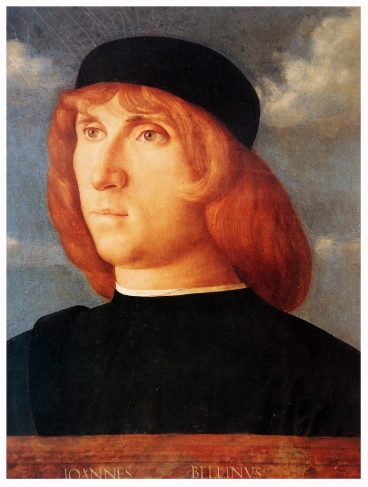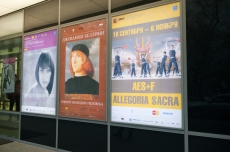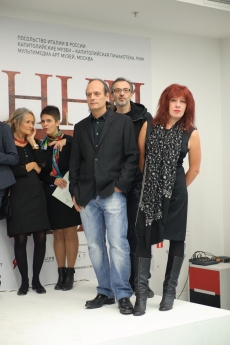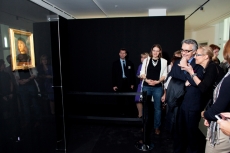This superb portrait by Giovanni Bellini was painted around 1490 and signed with the artist’s initials on the lower edge. By that time the celebrated Venetian artist had become one of the most important Italian Renaissance painters, by virtue of a style in which radiant colour is combined with delicate, meticulous representation.
Details
This superb portrait by Giovanni Bellini was painted around 1490 and signed with the artist’s initials on the lower edge. By that time the celebrated Venetian artist had become one of the most important Italian Renaissance painters, by virtue of a style in which radiant colour is combined with delicate, meticulous representation.
Here too our attention is focused on the main features of the picture: the fair-haired youth turned to the left of the composition gazes pensively ahead, his face and upper torso painted on a background of sky with scarcely discernible clouds. The young man with long hair covered by a simple cap is clad in an austere black garment with a ribbon (also black) just visible on his right shoulder, indicating the rank of a Venetian patrician. His name is unknown and we can only guess or imagine that he belongs to the higher echelons of the Most Supreme Republic of Venice and remain ignorant of his motives for commissioning such an enigmatic portrait from the illustrious Venetian painter. Was it a desire to show off, to celebrate his advance up the career ladder, or an attempt to halt the passage of time and create an illusion of mastery over physical decline and death?
Giovanni Bellini demonstrates his splendid command of the Flemish style of painting in this portrait on a poplar board, and in particular his familiarity with the style of Hans Memling. The art of Flanders, well known in Italy due to constant trade links, cultivated a taste for studied reticence and scrupulous, sometimes heartless, realism. Giovanni Bellini combined the lessons of Flemish artists with his knowledge of another style gleaned from the most important figure in the Italian Quattrocento, Antonello da Messina, who visited Venice for short periods in the mid-1470s. Antonello and Bellini progressed along parallel lines, creating a new, limpid form of painting that was very different from the creative path of Central Italian painters – their own distinctive view of the Renaissance.
The picture was acquired by Rome’s Capitoline Museums in 1750. The group of museums was already functioning by then and contained a large collection of archaeological exhibits brought here during the rule of Pope Sixtus IV, who donated bronze statues from the Lateran to ‘the Roman People’ (including the ‘Capitoline She-Wolf’ and ‘Boy With Thorn’). In the first half of the 18th century it was decided to augment the museum holdings with an extensive public collection of paintings – the first in Europe. This initiative was implemented by Pope Benedict XIV Lambertini and Cardinal Silvio Valenti Gonzaga, state secretary and prolific collector. Thus the Capitoline Picture Gallery – later renamed the Capitoline Pinacoteca and included in the Capitoline Museums – was enriched by the most important works of art from two well-known collections, the Sacchetti (1748) and the Pio. Giovanni Bellini’s painting originated from the Pio collection and suffered many vicissitudes of fate before arriving at the Capitoline.
When the collection was transferred to the Capitoline Museums the picture was erroneously thought to be a Venetian painter’s self-portrait, but the mistake was soon rectified. Eighteenth century experts disputed the attribution of the painting for some time, before reaching the unanimous conclusion that it was signed by Giovanni Bellini. Even more heated arguments ensued about the date, which oscillated from the early 1480s to the year 1515, the very end of the artist’s career. Although dating is complicated by the absence of any specific characteristics, experts believe the portrait was painted circa 1490.
Close









